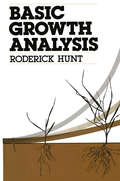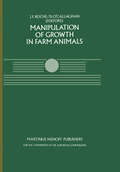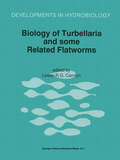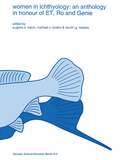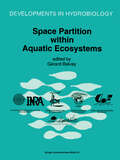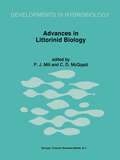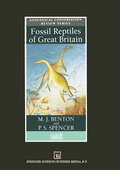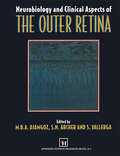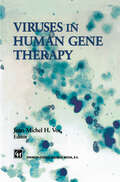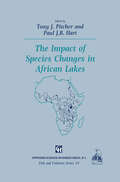- Table View
- List View
Die Zweiflügler (Dipteren) des Kais. Museums zu Wien
by F. Brauer J. von BergenstammDieser Buchtitel ist Teil des Digitalisierungsprojekts Springer Book Archives mit Publikationen, die seit den Anfängen des Verlags von 1842 erschienen sind. Der Verlag stellt mit diesem Archiv Quellen für die historische wie auch die disziplingeschichtliche Forschung zur Verfügung, die jeweils im historischen Kontext betrachtet werden müssen. Dieser Titel erschien in der Zeit vor 1945 und wird daher in seiner zeittypischen politisch-ideologischen Ausrichtung vom Verlag nicht beworben.
Basic Growth Analysis: Plant growth analysis for beginners
by R. HuntThis handbook is intended as an introductory guide to students at all levels on the principles and practice of plant growth analysis. Many have found this quantitative approach to be useful in the description and interpretation of the performance of whole plant systems grown under natural, semi-natural or controlled conditions. Most of the methods described require only simple experimental data and facilities. For the classical approach, GCSE biology and mathematics (or their equivalents) are the only theoretical backgrounds required. For the functional approach, a little calculus and statistical theory is needed. All of the topics regarding the quantitative basis of productivity recently introduced to the Biology A-level syllabus by the Joint Matriculation Board are covered. The booklet replaces my elementary Plant Growth Analysis (1978, London: Edward Arnold) which is now out of print. The presentation is very basic indeed; the opening pages give only essential outlines of the main issues. They are followed by brief, standardized accounts of each growth-analytical concept taken in turn. The illustrations deal more with the properties of well-grown material than with the effects of specific environmental changes, even though that is where much of the subject's interest lies. However, detailed references to the relevant parts of more com prehensive works appear throughout, and a later section on 'Inter relations' adds perspective. Some 'Questions and answers' may also help to show what topics will arise if the subject is pursued further.
Manipulation of Growth in Farm Animals: A Seminar in the CEC Programme of Coordination of Research on Beef Production, held in Brussels December 13–14, 1982 (Current Topics in Veterinary Medicine #26)
by J. F. RocheIn some countries, especially on the European continent, there still exists a remarkable veal market. This type of meat production seems, irrespective of any economic forecasts, to remain unchallenged so long as consumers expect that restaurants should offer courses like "r6ti de veaux", "vitello a la casa" or "Kalbsschnitzel". Producers, at least since about the past 1-/2 decades, have been aware of the beneficial effect of anabolic agents in veal production. This is possible due to the lack of endogenous sexual hormones during the juvenile or prepuberal status of these animals. A discussion about the benefit / risk - evaluation in connection with the use of anabolic agents in general was promoted in recent years by the public. This concern occurred concomitantly with the detection of illegally treated veal calves and the occurrence of diethylstilbestrol (DES) residues in canned food containing veal. The aim of this paper is to summarize the present status of residue data in edible tissues and excreta in order to allow the evaluation of the risk (given in the paper of Hoffmann within this program) and to consider reasonable monitoring measures. We have to face the fact that without an efficient control system the illegal treatment of calves can not be excluded. Therefore, this paper will not only consider different compounds and formulations, but will also deal with practised routes of administration.
The Physical Chemistry of MEMBRANES: An Introduction to the Structure and Dynamics of Biological Membranes
by B. SilverLs book is an account of what physical chemistry h . . to say about the structural, electrical and transport properties of biological membranes and their simplest model-the lipid bilayer. The accent throughout is on basic ideas. In contrast to the essentially descriptive ap proach characteristic of texts on membrane biochemistry, our underlying themes are the role of force and entropy in maintaining membrane organization, in determining the electric fields and ionic environment of membranes, and in regulating the passage of molecules and ions across membranes. Although experimental findings will always be the touch stone against which theory will be tried, no attempt is made to present an exhaustive survey of experimental data. On the other hand, there is discussion of the nature and limitations of the results obtainable by the major laboratory techniques. The treatment is at the level of an advanced undergraduate course or an introductory survey suitable for post graduate students carrying out research in biochemistry, biophysics, or physiology. The mathematical demands on the reader are trivial. The few forbidding equations appearing in Chapter 7 are soon whittled away to simple practical expressions. Although the current-voltage characteristics of nerves are traditionally the province of biophysics rather than physical chemistry, certain aspects relevant to the electrical activity of nerves are nevertheless included in this text, namely, mem brane and diffusion potentials and conductivity fluctuations. Where rival theories exist, conflicting convictions have been presented, but not necessarily accorded equal approbation. The author has a viewpoint.
Plant Molecular Biology (Tertiary Level Biology)
by Donald Grierson S.N. CoveyIn the preface to the first edition ofthis book, we expressed a conviction that there was a need for a short book that highlighted important advances in the new discipline of plant molecular biology. The rapid development of this topic has been brought about by the recognition of the unique properties of plants in the study of growth and development together with the application of recombinant DNA techniques to tackle these problems. Plant cells contain DNA in nuclei, plastids and mitochondria, and so ofTer the unique challenge of studying the interaction of three separate genetic systems in a single organism. The molecular approach has provided, in recent years, a wealth of important information about how plants function, and how they interact with bacteria, fungi and viruses. Furthermore, plant development involves the regulation of gene expression in response to internal and external signals, and plant molecular biology has provided a fundamental insight into how this development is regulated. This is not only of considerable scientific interest, but also has important implications for the production of plants and plant products in agriculture, horticulture and the food industries.
Viruses and the Environment
by J.I. CooperDuring the decade since the publication of the first edition of this important book, there has been a rapid advancement in the techniques of genetic engineering and molecular biology. In this edition Joseph Cooper takes those advances into account and includes such topics as gene therapy, immunosuppression and new viruses of human/veterinary significance. Much new information about virus transmission is also included and the most modern systems of virus taxonomy are used to emphasise the features shared between viruses in plants, animals and bacteria. This is the only book of its type which covers viruses in all forms of life.
Insect Natural Enemies: Practical approaches to their study and evaluation
by M. A. JervisOver the past three decades there has been a dramatic increase in theoretical and practical studies on insect natural enemies. The appeal of insect predators, and parasitoids in particular, as research animals derives from the relative ease with which many species may be cultured and experimented with in the laboratory, the simple life cycles of most parasitoids, and the increasing demand for biological pest control. There is now a massive literature on insect natural enemies, so there is a great need for a general text that the enquiring student or research worker can use in deciding on approaches and techniques that are appropriate to the study and evaluation of such insects. This book fulfils that demand. A considerably updated and expanded version of a previous best-seller, it is an account of major aspects of the biology of predators and parasitoids, punctuated with information and advice on which experiments or observations to conduct, and how to carry them out. Guidance is provided, where necessary, on the literature that may need to be consulted on particular topics. While researchers can now refer to several books on parasitoids and predators, Insects as Natural Enemies is unique in emphasising practicalities. It is aimed at students and professional working in universities and both government and commercial institutes in the fields of pest management, agriculture, horticulture and forestry.
Cladocera as Model Organisms in Biology: Proceedings of the Third International Symposium on Cladocera, held in Bergen, Norway, 9–16 August 1993 (Developments in Hydrobiology #107)
by Lawrence J. Weider PetterLarssonThe Third International Symposium on Cladocera, papers from which make up this volume, covered recent findings on the behaviour, life history, population genetics, reproduction, chemical communication, predator-prey interactions, epibionts, taxonomy, phylogeny, palaeolimnology and biogeography of this animal group. The Cladocera occupy an intermediate position in lake ecosystems, both as plankton and benthic organisms. Their often high abundance and their function, as transfer organisms from algae and dead organic matter to macro-invertebrates and fish, make them one of the most important organisms to affect the biological processes in freshwater ecosystems. The Cladocera living among the plankton often have recognizable distribution patterns and migrations; their size and brief life cycles make them popular in laboratory experiments; their cyclic parthenogenesis makes them suitable for many aspects of population genetics; and they are present as microfossils in lake sediments. All these features confer a unique status on the Cladocera as model organisms in many aspects of modern systematics and ecology.
Biology of Turbellaria and some Related Flatworms: Proceedings of the Seventh International Symposium on the Biology of the Turbellaria, held at Åbo/Turku, Finland, 17–22 June 1993 (Developments in Hydrobiology #108)
by Lester R. G. CannonTurbellaria, the mainly free-living flatworms, and some of their parasitic relatives, are among the simplest of the metazoa and, as such, provide ideal models for a wide range of fundamental studies. The 60 contributions to Biology of Turbellaria and some Related Flatworms cover taxonomy and phylogeny, biogeography and genetics, ecology and behaviour, Anatomy and ultrastructure, development and regeneration, genes and sequences, and neurophysiology. Biology of Turbellaria and some Related Flatworms is the most recent compilation in the series published in Hydrobiologia since 1981, covering research on these flatworms assembled by the world's leading authorities on the group. Audience: These papers present the advanced student and serious researcher with up to date information on an important, but often neglected group whose place in the animal kingdom demands greater attention.
Women in ichthyology: an anthology in honour of ET, Ro and Genie (Developments in Environmental Biology of Fishes #15)
by E. K. Balon Michael N. Bruton David L. G. NoakesThis special volume is dedicated to the contributions of women ichthyologists. Three colleagues were selected to represent all women ichthyologists, Ethelwynn Trewavas (ET), Rosemary Lowe-McConnell (Ro) and Eugenie Clark (Genie). All have had distinguished professional careers and have contributed in their own ways to their science. The career of each is highlighted by a personal interview with one of the editors of the volume, a bibliography of their lifetime publications, and a biography of their careers. Questions of historical inequities and current controversies in the treatment of women ichthyologists by their peers are raised and addressed by the women themselves. The personal and professional influences of these three women, and other women ichthyologists, are highlighted. A survey article by Pat Brown brings a number of women ichthyologists to the attention of a broader audience, and points the way for a more comprehensive historical consideration of the accomplishments and contributions of women ichthyologists. The volume continues with 16 solicited and contributed papers. ET's studies of taxonomy and life history are echoed in papers on the taxonomy and systematics of marine angelfishes, and of freshwater bitterlings, a review of reproduction in the North Atlantic ichthyofauna, and a comparison of reproductive styles and systematics of African minnows. Ro's studies on ecology, life history and behaviour are paralleled by papers on growth and metabolism in piranha, the community structure in tide pool fishes, and the social system and reproductive patterns in groupers. Genie's pioneering work on sexual roles and sex change, and her field studies of the behaviour of marine fishes are reflected in papers on gonadal structure and environmental sex determination in brook lamprey, sexual patterns in hawkfish, reproduction and systematics in phallostethids, gonadal structure and systematics in gobiids, reproductive and predator avoidance behaviour in razorfish, early ontogeny of an African mouth brooder, and alternative life histories in killifish.
Cell Culture Engineering IV: Improvements of Human Health (Current Applications of Cell Culture Engineering #1)
by B. C. BucklandCell Culture Engineering IV, Improvements of Human Health covers the latest approaches to improving the cell host through improved understanding of the molecular biology, the development of novel vaccines, approaches to bioreactor design and operation, monitoring techniques in process control and quality related topics. The work was carefully put together as one result of the Cell Culture Engineering IV Meeting held in San Diego, U.S.A. in 1994, however, the book may not be perceived as a proceedings volume - the criteria of the book series apply. For cell biologists, biochemists, molecular biologists, immunologists and other disciplines related to cell culture engineering, working in the academic environment, as well as in (biotechnology or pharmaceutical) industry.
Studies on Large Branchiopod Biology and Aquaculture II (Developments in Hydrobiology #103)
by Denton Belk Henri J. Dumont G. MaierThis book contains a collection of papers dealing with various aspects of the biology and aquaculture of the large branchiopod crustacea; the Anostraca, Conchostraca, and Notostraca. Included are many of the papers presented at the Second International Large Branchiopod Symposium convened in Ulm, Germany, 30 July--3 August 1993. Additional manuscripts contributed by colleagues who were unable to attend are also included. A special feature of this volume is a checklist of the Anostraca, including information on distribution, location of type material, taxonomic problems, and literature references.
Space Partition within Aquatic Ecosystems: Proceedings of the Second International Congress of Limnology and Oceanography held in Evian, May 25–28, 1993 (Developments in Hydrobiology #104)
by Gérard BalvayProceedings of the Second International Congress of Limnology and Oceanography held in Evian, May 25--28, 1993
Advances in Littorinid Biology: Proceedings of the Fourth International Symposium on Littorinid Biology, held in Roscoff, France, 19–25 September 1993 (Developments in Hydrobiology #111)
by P. J. Mill C. D. McQuaidMembers of the gastropod family Littorinidae are common throughout the world. They form a very abundant component of many intertidal and shallow subtidal ecosystems and, by their grazing, often play a central role in shaping these communities. They also display a wide range of life history strategies and many are polymorphic, making them attractive model organisms for ecologists, evolutionary biologists and physiologists alike. Areas of particular interest include ecological interactions with other animals and with algae, the effects of pollutants and the use of littorinids as sentinel species for monitoring pollution, the effects of parasites on growth and ecology, taxonomy, and the study of genotypic/phenotypic responses to environmental factors. There is still much to be done, and the littorinids are proving to be an ideal group on which to work. Audience: Primarily targeted at the research level. Will also provide useful information for advanced first-degree students conducting research projects.
Animal Cell Technology: Developments towards the 21st Century
by E. C. Beuvery W. P. Zeijlemaker J. B. GriffithsAnimal cell technology is a discipline of growing importance, which aims not merely at understanding structure, function and behaviour of differentiated animal cells, but especially at the development of their abilities useful for clinical application. Topics of interest in this regard include: viral vaccines, pharmaceutical proteins and novel applications such as gene therapy and organ culture. Undoubtedly, these Proceedings of the joint Meeting of the European Society for Animal Cell Technology and the Japanese Association for Animal Cell Technology (Veldhoven, The Netherlands, September 1994) review the most recent status of the field, and will be most valuable to anyone actively involved in the culture of animal cells and its applications. The contributions to this volume were strictly selected on the basis of quality and novelty of contents. Kluwer is honoured to be able to add this work to its strongly developing publication programme in cell and tissue culture, which now has its connections to all major Societies in this field worldwide. Audience: Cell biologists, biochemists, molecular biologists, immunologists, virologists and all other disciplines related to animal cell technology, working in an academic environment, as well as in (biotechnology or pharmaceutical) industry.
Medical History and Physical Examination in Companion Animals
by H. W. Vries A. Rijnberkcreation no falsification falsification Tl rejected creation etc. Figure 1-1 delivers such a result that the theory must be seen as an extension of Popper's rational proce discarded. In this way we come at the same time dure for theory elimination. to the border between science and nonscience: a Popper's naive falsifiability knows only one theory is scientific if it is falsifiable. It is thus way, the elimination of what is weak. The so not scientific to bring additional evidence to phisticated falsifiability, in contrast, knows only bear in vindication of the theory; the theory elimination in combination with the acceptance would thereby take on the character of an un of an alternative. According to sophisticated fal challengeable certainty of belief ('religion'). sifiability, a scientific theory T r is only aban Following Popper, others such as Kuhn, with doned if its place is taken by another theory T2 his paradigm theory, have considerably extended which has the following three characteristics: 1 the range of thought over what is scientific and T 2 has more empirical content than TI; the new what is not.
Fossil Reptiles of Great Britain
by M.J. Benton P.S. SpencerThis volume details all British sites that have yielded fossil reptiles, describing in detail the fifty most important localities and providing an extensive bibliography of everything published on British Fossil reptiles since 1676.
Neurobiology and Clinical Aspects of the Outer Retina
by M.B. Djamgoz S. Archer S. VallergaThis book deals with the cellular biology, biochemistry and physiology of photoreceptors and their interactions with the second-order neurons, bipolar and horizontal cells. The focus is upon the contributions made by these neurons to vision. Thus the basic neurobiology of the outer retina is related to the visual process, and visual defects that could arise from abnormalities in this part of the retina are highlighted in the first 16 chapters. Since all vertebrate retinas have the same basic structure and physiological plan, examples are given from a variety of species, with an emphasis upon mammals, extending to human vision. The last four chapters approach the problem from the other end. This part of the book covers a range of clinical conditions involving visual abnormalities that are due to cellular defects in the outer retina. Although the contents of this book do not represent the proceedings of a conference, the concept arose at an international symposium on 'Recent Advances in Retinal Research' which was held at the International Marine Centre in Oristano, Sardinia. We hope that the book will give a coherent, up to date review of the neurobiology and clinical aspects of the outer retina and encourage further integration of these areas. Retinal neurobiology has been an intense field of investigation for several decades. More recently, it has seen significant advances with the application of modern techniques of cell and molecular biology.
Molecular and Cell Biology of Human Gene Therapeutics (Molecular and Cell Biology of Human Diseases Series #20)
by G. Dicksonadvanced metastatic disease of solid tumors, dictates that each tumor mass, indeed each individual metastasis, will have a unique antigen and cytokine environment and hence unique response to immune modu lation. A differential response to immunotherapy is thus inevitable. 4. Many of the human trials described are not randomized and report survival or response against historical controls. Most tumors described are immunogenic human tumors: renal cell cancer and melanoma are most common. In order to avoid the well-described inter-patient vari ation and rare incidence of spontaneous response among patient samples as well as selection bias and changes in practice over time, randomized trials are required. 5. Immunological treatment is unlike conventional chemotherapy in its endpoint. Most chemotherapeutic regimes require a complete response or a good partial response for cure or good palliation. There are now many cases where immunotherapy has provided long-term palliation without massive tumor reduction. Immunity may be stimulated to a degree which holds tumorigenicity in check and most importantly, pro vides good palliation for the patient in a manner that differs essentially from chemotherapy.
The Role of Apoptosis in Development, Tissue Homeostasis and Malignancy: Death from inside out
by R.M. Dexter A.H. Wyllie M.C. RaffThe past five years have witnessed a remarkable development of interest in cell death 'from inside out'. After 30 years of relative obscurity, its quantitative importance in the building and maintenance of normal tissues, the subtle strategies involved in its regulation, and its significance in the pathogenesis of diseases of major social importance are becoming clear. Moreover, because a distinct set of biological events is involved in this death, these events themselves become reason able targets for new pharmacological agents in the treatment of cancer. The articles in this volume summarize the contents of a discussion meeting held at the Royal Society on 23 and 24 February 1994. The authors are a distinguished international group from a variety of disciplines in biology and medicine and hopefully their articles will convey something of the excitement of this fast-moving field. The three organizers are enormously indebted to all the contributors for the enthusiasm with which they delivered their talks, shared in discussion, and finally committed their contributions to these printed pages. We would also like to acknowledge the gracious way in which the Royal Society hosted the meeting, and in particular Mary Manning for making it the trouble-free and enjoyable experience that it was, and Janet Clifford and Simon Gribbin for skillfully managing the editorial processing of this volume. Michael Dexter June 1994 Martin Raff Andrew Wyllie x 1 Death from inside out: an overVIew ANDREW H.
Viruses in Human Gene Therapy
by J. VosW. French Anderson, M.D. The publication of this book comes at an opportune time for the young field of human gene therapy. After a decade of long struggle at the laboratory bench and many long hours under the harsh lights of the federal review process, gene therapy has emerged as a legitimate scientific discipline. It is now time to move away from the period of questioning whether gene therapy will be a useful part of the physician armamentarium to begin to actively teach the concepts and practices that make gene therapy a reality. This book is a comprehensive collection of chapters that describe the basic biology and potential application of viruses as gene transfer reagents. It is not a coincidence that a modified virus was the reagent used in the first human gene therapy trials. Viruses have evolved with the human species (and most likely with all forms of life) to be the masters of gene transfer.
The Impact of Species Changes in African Lakes (Fish & Fisheries Series #18)
by P. Hart T. J. PitcherThe African lakes are an extremely important ecosystem and the subject of much study relating to species introductions and loss of biodiversity. This book provides a thorough review of the whole subject and will be of great interest to fish biologists, fisheries workers, ecologists, environmental scientists and conservationists.
Active Oxygen in Biochemistry (Structure Energetics and Reactivity in Chemistry Series #3)
by Joan Selverstone Valentine Christopher S. Foote A. Greenberg Joel F. LiebmanThe field of "Oxygen Activation" has attracted considerable interest recently, not only because it presents challenges in those fields of basic research that aim to understand the fundamental aspects of chemical and biological reactions that involve dioxygen, but also because of its wide range of practical implications in such diverse fields as medicine, synthesis of pharmaceuticals and other organic compounds, materials science, and atmospheric science. This is the second of two volumes that focus on the subject of oxygen activation, the first slanted toward chemistry and the second toward biological chemistry. We planned these volumes to be more general than many monographs of this sort, not as detailed summaries of the authors' own research but rather as general overviews of the field. Our choice of topics was strongly influenced by our syllabus for a course entitled "Oxygen Chemistry," which two of us have twice taught jointly at UCLA. Definition of important issues, horizons, and future prospects was an important goal, and, although totally comprehensive coverage was not possible, we believe that we have chosen a representative selection of research topics current to the field. We have targeted this work to a diverse audience ranging from professionals in fields from physics to medicine to beginning graduate students who are interested in rapidly acquiring the basics of this field.
Preservation of Surfactant Formulations
by F. MorpethMicrobes are known to live in an enormous range of environments. Their ability to survive and proliferate in diverse industrial systems is often a surprise to those not exposed to these problems in their work. These systems contain a range of potential carbon sources, one common theme being surfactants. Surfactants are often not the components most prone to spoilage since some systems contain highly susceptible natural components, such as starch and xanthum gum, but the surfactant is a key part of the formulation, and its extensive breakdown usually means that the material is beyond recovery. The aim of this book is to describe in detail all aspects of the preservation of surfactant containing materials. The book should be viewed as being in three discrete sections. • chapters 1-5 deal with and summarise essential background information • chapters 6-11 discuss in detail various end use applications • chapters 12-15 outline the regulatory and toxicology implication associated with the safe handling of preservatives Given the format of the book there is inevitably some duplication of information in the middle section with different authors describing essentially the same phenomena but on different substrates. I hope the reader will find that although different chapters touch on the same topics the information around these areas is sufficiently different to justify their inclusion in this book and to be of interest. It should also demonstrate what can be the most useful source of information, the hard practical experience of the authors.

